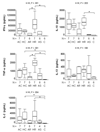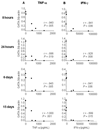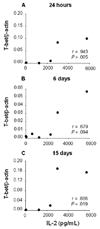T-bet, GATA-3, and Foxp3 expression and Th1/Th2 cytokine production in the clinical outcome of human infection with Leishmania (Viannia) species
- PMID: 20583921
- PMCID: PMC4850829
- DOI: 10.1086/653829
T-bet, GATA-3, and Foxp3 expression and Th1/Th2 cytokine production in the clinical outcome of human infection with Leishmania (Viannia) species
Abstract
Background: T cell differentiation determines susceptibility and resistance to experimental cutaneous leishmaniasis, yet mixed T1/Th2 responses characterize the clinical spectrum of human infection with Leishmania (Viannia) species.
Materials and methods: To discern the interrelationship of T cell differentiation and outcome of human infection, we examined factors that regulate T cell differentiation and Th1/Th2 cytokine responses in asymptomatic infection, active and historical chronic and recurrent cutaneous leishmaniasis. T-bet, GATA-3, Foxp3, and cytokine gene expression were quantified by real-time polymerase chain reaction and correlated with interleukin 2, interferon gamma, tumor necrosis factor alpha, interleukin 4, interleukin 13, and interleukin 10 secretion during in vitro response to live Leishmania panamensis.
Results: Higher GATA-3 expression than T-bet expression occurred throughout the 15 days of coculture with promastigotes; however, neither transcription nor secretion of interleukin 4 was detected. A sustained inverse correlation between GATA-3 expression and secretion of proinflammatory cytokines interferon gamma and tumor necrosis factor alpha was observed in asymptomatic infection. In contrast, higher T-bet expression and a higher ratio of T-bet to GATA-3 characterized active recurrent disease. Down-regulation of T-bet and GATA-3 expression and increased interleukin 2 secretion, compared with control subjects, was directly correlated with Foxp3 expression and interleukin 13 secretion in chronic disease.
Conclusions: Regulation of the inflammatory response rather than biased Th1/Th2 response distinguished asymptomatic and recalcitrant outcomes of infection with Leishmnania viannia species.
Conflict of interest statement
None of the authors have a commercial or other association that might pose a conflict of interest in the conduct of this study or the publication of the results
Figures






Similar articles
-
Expression of Th1 and Th2 cytokine-associated transcription factors, T-bet and GATA-3, in peripheral blood mononuclear cells and skin lesions of patients with psoriasis vulgaris.Arch Dermatol Res. 2010 Sep;302(7):517-23. doi: 10.1007/s00403-010-1048-1. Epub 2010 Mar 24. Arch Dermatol Res. 2010. PMID: 20333526
-
Elevated gene expression of Th1/Th2 associated transcription factors is correlated with disease activity in patients with systemic lupus erythematosus.J Rheumatol. 2007 Jan;34(1):89-96. Epub 2006 Nov 15. J Rheumatol. 2007. PMID: 17117487
-
T-bet/GATA-3 ratio as a measure of the Th1/Th2 cytokine profile in mixed cell populations: predominant role of GATA-3.J Immunol Methods. 2003 Jul;278(1-2):157-69. doi: 10.1016/s0022-1759(03)00200-x. J Immunol Methods. 2003. PMID: 12957404
-
An updated view on transcription factor GATA3-mediated regulation of Th1 and Th2 cell differentiation.Int Immunol. 2011 Jul;23(7):415-20. doi: 10.1093/intimm/dxr029. Epub 2011 Jun 1. Int Immunol. 2011. PMID: 21632975 Free PMC article. Review.
-
More than just a T-box: the role of T-bet as a possible biomarker and therapeutic target in autoimmune diseases.Immunotherapy. 2011 Mar;3(3):435-41. doi: 10.2217/imt.10.111. Immunotherapy. 2011. PMID: 21395384 Free PMC article. Review.
Cited by
-
Transcriptome patterns from primary cutaneous Leishmania braziliensis infections associate with eventual development of mucosal disease in humans.PLoS Negl Trop Dis. 2012;6(9):e1816. doi: 10.1371/journal.pntd.0001816. Epub 2012 Sep 13. PLoS Negl Trop Dis. 2012. PMID: 23029578 Free PMC article.
-
A Mouse Model of Ulcerative Cutaneous Leishmaniasis by Leishmania (Viannia) panamensis to Investigate Infection, Pathogenesis, Immunity, and Therapeutics.Front Microbiol. 2022 Jun 13;13:907631. doi: 10.3389/fmicb.2022.907631. eCollection 2022. Front Microbiol. 2022. PMID: 35770175 Free PMC article.
-
Ex vivo host and parasite response to antileishmanial drugs and immunomodulators.PLoS Negl Trop Dis. 2015 May 29;9(5):e0003820. doi: 10.1371/journal.pntd.0003820. eCollection 2015 May. PLoS Negl Trop Dis. 2015. PMID: 26024228 Free PMC article.
-
Antileishmanial activity of a new chloroquine analog in an animal model of Leishmania panamensis infection.Int J Parasitol Drugs Drug Resist. 2020 Dec;14:56-61. doi: 10.1016/j.ijpddr.2020.08.002. Epub 2020 Aug 15. Int J Parasitol Drugs Drug Resist. 2020. PMID: 32950020 Free PMC article.
-
IFN-γ Response Is Associated to Time Exposure Among Asymptomatic Immune Responders That Visited American Tegumentary Leishmaniasis Endemic Areas in Peru.Front Cell Infect Microbiol. 2018 Aug 21;8:289. doi: 10.3389/fcimb.2018.00289. eCollection 2018. Front Cell Infect Microbiol. 2018. PMID: 30186774 Free PMC article.
References
-
- Marsden PD. Clinical presentations of Leishmania braziliensis braziliensis. Parasitol Today. 1985;1:129–133. - PubMed
-
- Weigle KA, Saravia NG. Natural History, Clinical Evolution, and the Host-Parasite Interaction in New World Cutaneous Leishmaniasis. Clin Dermatol. 1996;14:433–450. - PubMed
-
- Saravia NG, Weigle KA, Segura I, et al. Recurrent lesions in human Leishmania braziliensis infection: reactivation or reinfection? Lancet. 1990;336:398–402. - PubMed
-
- Ramírez JL, Guevara P. Persistent infections by Leishmania (Viannia) braziliensis. Mem Inst Oswaldo Cruz. 1997;92:333–338. Review. - PubMed
-
- Schubach A, Marzochi MC, Cuzzi-Maya T, et al. Cutaneous scars in American tegumentary leishmaniasis patients: a site of Leishmania (Viannia) braziliensis persistence and viability eleven years after antimonial therapy and clinical cure. Am J Trop Med Hyg. 1998;58:824–827. - PubMed
Publication types
MeSH terms
Substances
Grants and funding
LinkOut - more resources
Full Text Sources
Medical
Molecular Biology Databases

